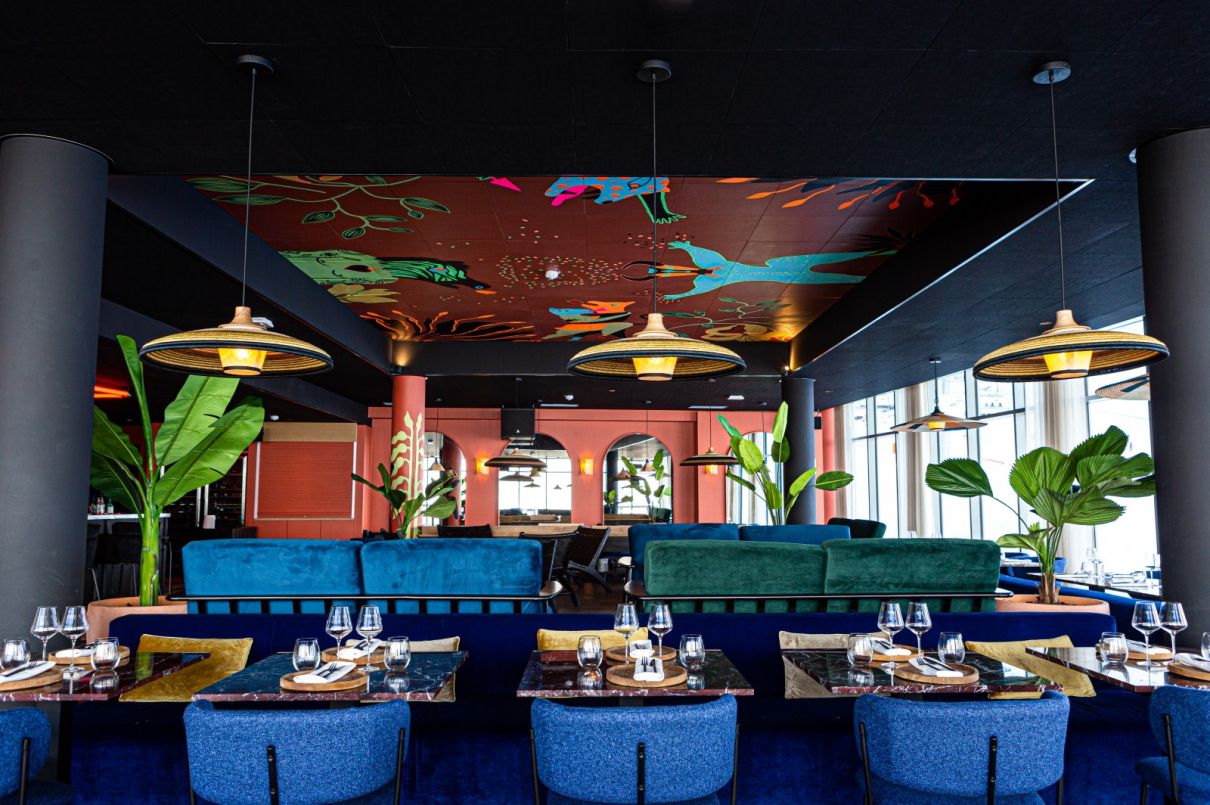Flavours of the South

Latin American cuisine is increasingly top of the menu at the world’s most sought after restaurants.
If you’re thinking tacos and fajitas, think again. Latin American cuisine is gaining an elevated status in some of the world’s most sought-after restaurants. We speak to three young chefs leading the movement.
Santiago Lastra

London KOL owner Santiago Lastra, who has earned his first Michelin star, has lived away from his home country for 17 years. He says: “The most important thing is to get to know the local produce and how to cook with what you have around you.”
What ingredient from your home country do you miss most?
Citrus is one of the pillars of Mexican cuisine so it can be challenging to cook without it. I miss lime and orange the most. At KOL we’ve developed lots of ways to replace this: we ferment our own kombucha, ageing it for about six months to replicate the same flavour profiles as orange or sour orange. Instead of using lime, we use Douglas fir, gooseberries, or sea buckthorn. Our langoustine taco is a great example of this: our sourdough tortillas come with langoustine, smoked chili, sea buckthorn, sauerkraut and a fermented langoustine head on the side that one squeezes as if it were a slice of lime.
What ancient recipe do you revisit?
I’d say one of my favourite dishes to cook is mole, which means to blend. There are lots of different varieties, some versions are more authentic than others. In Morelos where I’m from, there is a traditional red mole, it’s both sweet and savoury with lots of depth. To make it, you need about 25-30 ingredients; it’s almost our equivalent to a curry everyone has their own recipe for. At KOL, we take inspiration from the Oaxacan recipe for coloradito mole, but we use British ingredients to recreate it. Instead of plantain we use parsnips, we add carrot, onion, garlic, chili, sesame, almonds, some chocolate from the east coast of Mexico, along with some carrot juice and seaweed oil. The dish comes with smoked purple carrot, fermented blackcurrant, and is served with fresh tortillas.
What traditional ingredient have you revived?
Corn is a very important part of Mexican cooking, so we work directly with indigenous communities. Supporting them means they can grow heritage corn, which they struggle to sell in Mexico for the right price. We work with a collective called Tamoa, which visits communities and buy their produce at the right price. There are so many mass-produced tortillas full of pesticides; yet the moment you try a tortilla that’s made with an ancient corn variety, there’s no turning back.
Enrique Casarrubias

At the helm of Oxte restaurant near l’Étoile, Paris, Mexican chef Enrique Casarrubias brings colourful, spicy and charred flavours to French cuisine. The chef, who worked at Le Crillon and rose to become Akrame Benallal’s sous-chef, was recently awarded a Michelin star.
What ingredient from your home country do you miss most?
I miss the number and varieties of tortillas, especially the one we make using blue maize. Deeply rooted in Hopi traditions for over 7,000 years, it is central to their culture: drought-resistant, rich in protein, it was always essential to their cuisine. It gives tortillas a richer, denser taste. Today, we make traditional, soft and crispy yellow tortillas respecting the traditions. Using the corn dough, we bake spinach and cheese quesadillas, or craft taquitos — half-size crispy tacos — filled with fried oxtail and served with raw sour cream, a chili sauce and grated cheese.
What ancient recipe do you revisit?
My focus at Oxte is to re-enact recipes from my childhood and upbringing in Mexico. For example, my Acapulco-style ceviche is a take on a local recipe. The thinly sliced seabass is marinated for six hours with different citrus (lime, orange, mandarin, lemon), sliced onions, coriander, parsley, grape seed oil, apple vinegar and, most importantly, a burnt alpena tatemar chili.
What traditional cooking technique have you revived?
I use a traditional cooking technique called tatemar. It consists of overcooking or burning the upper layer of an ingredient to bring its bitterness out. Burning maize leaves, for example, or the skin of an avocado will completely change the taste of the cob or the fruit’s flesh. Tatemar, which comes from the word tatemado, is rooted in pre-Hispanic traditions. It is derived from nahuatl tlatemati, which means to burn, fire. Whenever I can, I flame-grill to bring smokiness and a clear contrast inside a dish.
How difficult is it to create dishes that will be sampled with wine?
Our aim at Oxte is to adapt to French taste and local seasonal produce. We have Mexican wines on our list — such as a Nebbiolo from Monte Xanic in the Guadalupe Valley, or Vino de Piedra from Casa das Piedra — and welcome some of France’s Grands Crus — Vosne-Romanée, Clos de Vougeot, Pommard, Aloxe-Corton, Grand Échezeaux — which are ideally paired with charred meat dishes.
Juan Arbelaez

A Colombian native, young chef Juan Arbelaez has quickly made a name for himself in Paris with restaurant Bazurto, which celebrates the sunny, spicy and festive side of his South American heritage. Recently, the celebrated chef opened Bazurto Tignes in the Alps.
What ingredient from your home country do you miss most?
At home in Colombia, the tradition of fresh juices is very important; it simply doesn’t exist here in Europe. In the restaurant, I’ve adapted a white-chocolate dessert with passion fruit. Since the fruits are more acidic, we mix them with a sweeter cream. We add a smoked paprika crumble, a white-chocolate cream, and finish it off with a passion fruit coulis, sorbet and fresh fruit.
What ancient recipe do you revisit?
More than a traditional dish, I chose to revisit the empanada. Everywhere you eat it with your fingers in the street and dip it into aji. Street food is an essential part of the Colombian culture, a shared moment. Whether filled with meat or fish, the empanada is always the same, yet always different. I revisit it using a maize and quinoa dough filled with daily market vegetables.
What traditional cooking technique have you revived?
In Colombia, cooking with fire is the main technique. Today, I would love to rely on firewood grills to bring complexity and spice to my dishes but the regulation in France is strict when it comes to having an open fire in the kitchen. I resort to smoking ingredients using different types of small wood scraps from beech, pine or olive trees. For example, roasted poultry comes with coconut cream that is smoked using scraps and a citrussy beurre noisette. It instantly brings me back to my childhood.
Did you have to adapt to European tastes?
At home, for example we eat very spicy food, which the French palate can’t take. It all comes down to adjusting recipes or drawing parallels. For example, we eat a lot of fresh grilled cheese, which I reinterpret in Tignes using local fresh cheese that tastes different. Adapting isn’t a constraint, it’s a richness.
How difficult is it to create dishes that will be sampled with wine?
I’ve become passionate about wines; some of the rich whites work so well with a spicy, exotic cuisine. On the wine list, only 10 percent of the wines are South American — from Chile, Uruguay and Argentina — but we also play around a lot with smoked mezcals and aguardiente, for example.








